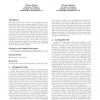Free Online Productivity Tools
i2Speak
i2Symbol
i2OCR
iTex2Img
iWeb2Print
iWeb2Shot
i2Type
iPdf2Split
iPdf2Merge
i2Bopomofo
i2Arabic
i2Style
i2Image
i2PDF
iLatex2Rtf
Sci2ools
CCR
2011
2011
Application flow control in YouTube video streams
This paper presents the results of an investigation into the application flow control technique utilised by YouTube. We reveal and describe the basic properties of YouTube application flow control, which we term block sending, and show that it is widely used by YouTube servers. We also examine how the block sending algorithm interacts with the flow control provided by TCP and reveal that the block sending approach was responsible for over 40% of packet loss events in YouTube flows in a residential DSL dataset and the retransmission of over 1% of all YouTube data sent after the application flow control began. We conclude by suggesting that changing YouTube block sending to be less bursty would improve the performance and reduce the bandwidth usage of YouTube video streams. Categories and Subject Descriptors C.2.0 [Computer Communications Networks]: General General Terms Measurement, Performance Keywords YouTube, Flow Control, Block Sending, Packet Loss, DSL
| Added | 13 May 2011 |
| Updated | 13 May 2011 |
| Type | Journal |
| Year | 2011 |
| Where | CCR |
| Authors | Shane Alcock, Richard Nelson |
Comments (0)

